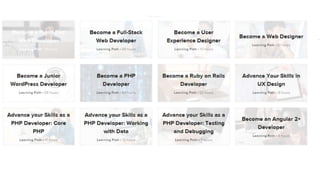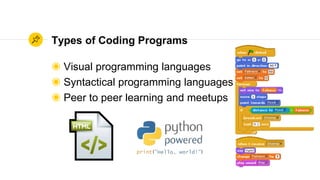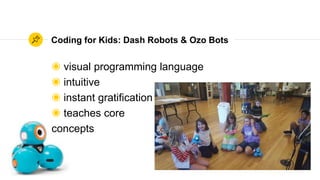STEAM & Making in Informal Learning Environments Community of Practice - Coding Learning Day
- 1. Coding Learning Day Mike Cimino Founding Member Sue Considine Founder SMILE Community of Practice May 3rd, 2017 Pete Cioppa Founding Member Leah Kraus Founding Member Margaret Portier Founding Member
- 2. Agenda 10-10:30 AM: Introduction: Why Coding in Informal Learning Institutions? 10:30-11:30 AM: Group A: Scratch Group B: Lego Coding & Sphero 11:30-12:30 PM: Group B: Scratch Group A: Lego Coding & Sphero 12:30-1:30 PM: Lunch 1:30-3 PM: Group A: Arduino Group B: HTML 3-3:30 PM: Share what you’re doing with coding at your organization; Q&A
- 3. Why Coding? Why informal learning environments? Why now? 1
- 4. Computers and software are changing everything Teaching computer coding allows us to support a true read-write culture
- 5. “ .
- 6. Did you know? Source: https://code.org/advocac y/state-facts/NY.pdf 9 in 10 parents want their child to study computer science 4 in 10 schools teach computer programming
- 7. Some may think computer science education is on the rise. In reality it is recovering from a ten year decline Source: National Science Foundation, National Center for Education Statistics FEMALE MALE 0 5,000 10,000 15,000 20,000 25,000 30,000 35,000 40,000 45,000 50,000 2000 2001 2002 2003 2004 2005 2006 2007 2008 2009 2010 2011 2012 2013 2014
- 8. 31,441Open computing jobs 14% of schools teach AP computer science 3,801Computer science graduates InNewYork Sources: The Conference Board, National Center for Education Statistics, and the College Board.
- 9. 71% Of new STEM jobs are in computing 8% of STEM graduates are in Computer Science
- 10. Some people may think computer science is a niche skill only certain experts need to know. In reality, computer science is about logic, problem solving, and creativity.
- 11. How do you accomplish this with existing staff skills and competing priorities?
- 12. Staffing and Staff Training ◉Provide ample opportunities for training existing staff ◉Think outside of the box in hiring decisions ◉“We can learn together” approach ◉What can we stop doing?
- 15. Coding at the FFL
- 16. Types of Coding Programs ◉ Visual programming languages ◉ Syntactical programming languages ◉ Peer to peer learning and meetups
- 17. Coding for Kids: Dash Robots & Ozo Bots ◉ visual programming language ◉ intuitive ◉ instant gratification ◉ teaches core concepts
- 18. Coding for Teens: Minecraft Mods ◉ Written in Java ◉ Focus on creating and altering, not just consuming
- 19. Place your screenshot here Coding for Teens & Adults: Python Beginner friendly, scalable, strong community
- 22. Questions? Sue Considine Founder SMILE Community of Practice [email protected]
Editor's Notes
- #2: SUE
- #4: SUE To begin: Why is coding so important? And as informal learning environments, what should our role be providing in coding and computer science education?
- #5: SUE We are all in the information and learning business, and it’s pretty clear to us that recent technological advances have strikingly changed the way we interact with each other and our environments. Technology has markedly changed our behaviors regarding information creation, sharing and seeking. In the world of blogs, chatrooms, wikis, listservs, and social media, we are more commonly seeking out information from our peers, rather than exclusively from experts. And in turn, we are recognizing that we are experts in our own particular ways, with valuable knowledge to share. We want to be able to contribute to the conversation, to create content and share our talents and what we know, in addition to simple consumption. This changing information landscape may prove to be a great opportunity for informal learning environments, if we can make the necessary mindshift to accompany it. We need to recognize that it is no longer enough to simply provide our community with information materials for consumption. Instead, we can remain vital by supporting a read-write culture in our communities, providing opportunities for community members to learn and share openly with one another. IF we can recognize that our community members are experts, we can play a crucial role by providing them the tools and opportunities to share their own expertise.
- #6: SUE In April 2016, the American Library Association and Google partnered to launch the “Libraries Ready to Code” project to investigate the current nature of coding activities in public and school libraries for youth and to broaden the reach and scope of this work. At the ALA midwinter conference Ready to Code will present updates on the progress of this initiative and continue to build on what we learn to develop a deeper understanding of how libraries do and should contribute to more opportunities to develop computational thinking for all ages in our communities. Need more Convincing?
- #7: SUE Did you know: Computer science IS NOT widely taught in our schools A recently released Gallup survey of parents and school administrators shows the stark gap between what parents want and what is happening in our schools 93% of parents surveyed WANT their child to learn computer science But only 40% of schools actually offer computer science classes
- #8: SUE Some may think computer science education is on the rise. In reality is is recovering from a ten year decline as you can see on the slide There are fewer students graduating with a degree in computer science than there were 10 years ago. And the number of women graduating with computer science degrees is half of what it was in 2003.
- #9: SUE Indeed, there is: No dedicated state funding for CS There is no requirement or mandate for all high schools to offer CS No K-12 CS curriculum standards This is despite the staggering job opportunities in computer science. IN NY , there are currently 31,000 open computing jobs (more than 4 times the average demand rate in New York). The average salary for a computing occupation in NY is over $98,000, which is significantly higher than the average salary in the state of $57,000. These existing open jobs alone represent a $3 Billion opportunity in terms of annual salaries. However, New York had only 3,800 computer science graduates in 2015; only 18% of these were female.
- #10: SUE We all know that jobs in STEM fields are on the rise. But did you know that 71% of new STEM jobs are in computing? And only 8% of STEM grads are in computer science? Informal learning environments need to act NOW to step in, create understanding about the importance of computer science education, and work to fill the education gap. We have the flexibility to create new opportunities more quickly than schools might be able to, as well to help support educators and students in moving in this direction.
- #11: SUE Some people may think computer science is a niche skill only certain experts need to know. The reality is that computer science is about logic, problem solving, and creativity It teaches people how to think differently about problems they are trying to solve in any context A very simple way to think about this is that computer science teaches kids how to CREATE new technologies instead of just consuming technology. This points back to the truly literate read-write culture that libraries are perfectly positioned to nurture and support.
- #12: Leah So how do we support coding and computer science education at our organizations with existing staff skills and competing priorities?
- #13: To begin with, we make it a top priority to provide ample opportunities for training existing staff related to coding. We want all of our staff to at least have a basic level of knowledge about coding and its importance, and of course, staff who lead coding programs need time and resources to be able to gain a higher level of transferable skills. To this end, we have encouraged our County System to subscribe to resources like Lynda.com on behalf of both our patrons and staff. Lynda provides access to instruction on a huge variety of coding and computer science courses for everyone from beginners to professionals. We have focused on staff training on this topic during our Annual Staff Development Day, and also in our monthly staff forum meetings We also recognize that with this new mandate to support 21st century literacy skills like computer science, it’s time to think outside of the box in our hiring decisions. We should be looking for candidates that have STEM and coding skills, and in fact, we have a professional position on our team for a Director of STEAM and Making, who does not have a library science background. We always take a “let’s learn together” approach – meaning that even while we’re providing community members with training on a coding language, we recognize that we are not going to know the answer to every question that might come up, but we can help them find the answer. We also need to ask ourselves – What are we currently spending our time and resources on that is no longer relevant to our community? What can we stop doing in order to reallocate time and resources towards this area of learning, where there is such a clearly demonstrated need and interest?
- #14: Leah Here are some examples of the types of in-depth learning our staff and patrons can access through Lynda.com You’ll also want to check out a resource called Webucator. They have similar training opportunities available for free, through their library partner program. For more info, go to webucator.com
- #15: Leah Additionally, we have made a concerted effort to connect with individuals and organizations in our area to provide additional access to coding learning opportunities, in addition to what our staff is able to support. We’ve teamed with organizations like Girls Develop IT, Code Like a Girl, SmartFast Code, and others to offer free coding classes at the library. We have also sought out volunteers with this particular skill area, like David, who you see in the picture here, to teach web development courses.
- #16: So, I want to share just a couple of quick examples of coding programs we’ve offered
- #17: Leah We usually think about these programs in three main categories. First, there are introductory coding programs that hook students and get them interested by teaching programming logic. These sessions often utilize software and tools that allow kids to start coding right away, without learning a specific language’s syntax. These are sometimes called “visual programming languages,” and feature intuitive software with drag and drop commands that get kids off to a fast and fun start. This type of coding is ideal for standalone programs, because participants can accomplish a lot in a single session, even if you only have half an hour together. Second, we offer coding classes that teach specific syntactic programming languages like HTML and Python. They are a little more challenging, because students learn a specific syntax of symbols and rules as they write lines of code. These classes are often a series, spread over four to eight weeks with each week building on the previous. The last style is a meetup style event or self-guided environment that focuses more on bringing students together, but allows them to practice peer-to-peer learning or work on their own projects at their own pace. You are all going to get experience a few examples of visual programming languages and a synatical programming language today.
- #18: For those of you who were here at our Maker Technology Learning Day, you got a chance to see the Dash Robots. Dash is a robot that can move around, make sounds, light up, and even respond to stimuli in the environment when its sensors detect a sound or an obstruction. The robot itself costs about $150, as is great to use with Kindergartners through fifth grade and up. Dash is controlled via Bluetooth by a free iPad app called Blockly. The app allows kids to drag and drop blocks of code like “Forward 50cm Fast” and “Say Hi”. This tool is great for younger and older kids alike because it has an intuitive interface and it is instantly gratifying to see Dash act out your code. You can also start to introduce some more advanced concepts, like conditionals, in a relatively simple way. We have used a single Dash robot with groups of up to five students, sometimes around prompts like “tell a story with Dash as your main character and have him respond to three things around him.” This helps kids to begin thinking about more complex code, like “If Dash Obstacle In Front” then, what should happen?
- #19: Leah As you probably know, Minecraft is a super popular computer game with kids and teens, that lets players create and interact with a virtual environment. We offer opportunities for teens who like playing minecraft to learn how to write code to modify it. Players learn how to use computer coding and design skills to make changes the visual aspects of the game, and also how to add and adjust items and interactions within the game. This course involves students learning not only how to write Java code, but also how to design and create digital graphics.
- #20: Leah Python is a general-purpose language, which means it can be used to build just about anything, from tools for backend web development, to data analysis, from artificial intelligence to productivity tools, games, and desktop apps. Python was designed to be easy to understand and fun to use. Since you'll be able to build prototypes and tools quickly with Python, many find coding in Python a satisfying experience. Thus, Python has gained popularity for being a beginner-friendly language. It also has a great community of programmers who provide documentation and answer one another’s questions, so it’s easy to find help. Our python classes are run by a community volunteer.
- #21: We know that many people in our community do not realize that the library offers learning opportunities and resources to support the development of computer science skills. So, we make it a point to feature coding during any of our outreach events, as well as to have a presence at coding initiatives happening in our community. For example, when we had tables at the YMCA and Trader Joe’s during National Library week, we brought Ozobots with us, and invited interested kids to come and attend a Lego Robotics coding program the following week. We also team with our local school districts to be present and assist at their Hour of Code events, which draw hundreds of students, and push our coding opportunities there.
- #22: LEAH As with all of our programs, we use our proposal template when planning coding programs. There is a copy of this in your folders. This ensures that with any and all of our coding programs, we are set up in a way to meet our goals and outcomes and the community’s goals and outcomes. This ensures that we are allocating resources appropriately, that we have an actionable plan and place to start, that we are collecting important evidence to make decisions on how to grow or change the program in the future, etc.
- #23: Sue: Before we jump into the hands-on sessions, we want to encourage you to let us know if you find today’s session valuable and would like to see this content offered to your colleagues in your region. Please approach one of us or indicate on the form in your folder if you’d like to host a similar learning day in your area at your organization.






















